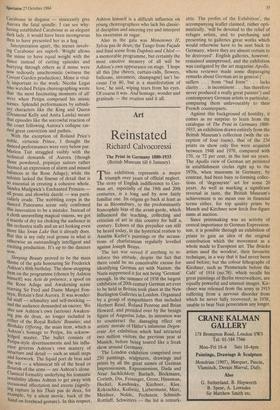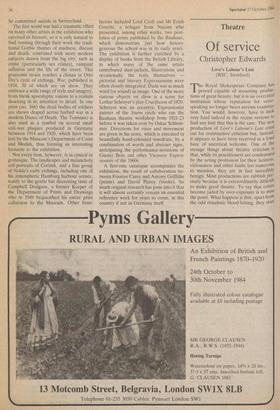Art
Reinstated
Richard Calvocoressi
The Print in Germany 1880-1933 (British Museum till 6 January)
This exhibition represents a major triumph over years of official neglect. The story of English indifference to Ger- man art, especially of the 19th and 20th centuries, is a long and by now fairly familiar one. Its origins go back at least as far as Bloomsbury, to the predominantly francophile bias of the avant-garde, which influenced the teaching, collecting and criticism of art in this country for half a, century. Echoes of this prejudice can still be heard today, in the hysterical reation to Anselm Kiefer's paintings or the accusa- tions of charlatanism regularly levelled against Joseph Beuys.
The last war served if anything to re- inforce this attitude, despite the fact that there could be no conceivable excuse for identifying German art with Nazism: the Nazis suppressed it for not being 'German' enough. In the summer of 1938 the largest exhibition of 20th-century German art ever to be held in Britain took place at the New Burlington Galleries in London. Organised by a group of sympathisers that included Herbert Read, Roland Penrose and Brian Howard, and presided over by the benign figure of Augustus John, its intention was to counteract the damaging effect on artists' morale of Hitler's infamous Degen- erate Art exhibition which had attracted two million visitors the previous year at Munich, before being toured like a freak show around Germany.
The London exhibition comprised over 250 paintings, sculptures, drawings and prints by all the great names of German Impressionism, Expressionism, Dada and Neue Sachlichkeit: Barlach, Beckmann, Corinth, Dix, Feininger, Grosz, Hausman, Heckel, Kandinsky, Kirchner, Klee, Kokoschka, Kollwitz, Liebermann, Marc, Meidner, Nolde, Pechstein, Schmidt- Rottluff, Schwitters — the list is remark-
able. The profits of the Exhibition', the accompanying leaflet claimed, rather opti- mistically, 'will be devoted to the relief of refugee artists, and to purchasing and presenting to galleries great works which would otherwise have to be sent back to Germany, where they are almost certain to be destroyed'. English galleries, however, remained unimpressed, and the exhibition was castigated by the art magazine Apollo. whose reviewer made some disparaging remarks about German art in general (`. . . suffers . . . from "bad form" . . . lacks clarity . . . is incontinent . . has therefore never produced a really great painter') and contemporary German artists in particular, comparing them unfavourably to their French counterparts.
Against this background of hostility, it comes as no surprise to learn from the catalogue of The Print in Germany 1880- 1933, an exhibition drawn entirely from the British Museum's collection (with the ex- ception of four loans), that of the 234 prints on show only five were acquired between 1948 and 1978, compared with 170, or 72 per cent, in the last six years. The Apollo view of German art persisted in establishment circles right up to the 1970s, when museums in Germany, by contrast, had been busy re-forming collec- tions of 'degenerate' art for some 20 years. As well as marking a significant reversal in taste, the British Museum's achievement is no mean one in financial terms either, for top quality prints by Munch and Kirchner now fetch five-figure sums at auction.
Since printmaking was an activity of central importance to German Expression- ism, it is possible through an exhibition of prints to gain an idea of the original contribution which the movement as a whole made to European art. The Briicke artists used the woodcut, their favourite technique, in a way that it had never been used before; but the colour lithographs of Kirchner, such as 'Promenade before the Café' of 1914 (no.78), which recalls his great paintings of Berlin streetwalkers, are equally powerful and unusual images. Kir- chner was released from the army in 1915 suffering from a nervous disorder from which he never fully recovered; in 1938, unable to bear Nazi persecution any longer, he committed suicide in Switzerland.
The first world war had a traumatic effect on many other artists in the exhibition who survived its horrors, so it is only natural to find running through their work the tradi- tional Gothic themes of madness, disease and death, combined with more modern subjects drawn from the big city, such as crime (particularly sex crimes), rampant inflation and the life of the street. This gruesome strain reaches a climax in Otto Dix's cycle of etchings, War, published in 1924, 30 of which are on show. They embrace a wide range of style and imagery, from bleak apocalyptic visions to a realism shocking in its attention to detail. In one print (no. 166) the dead bodies of soldiers are shown draped across barbed war in a modern Dance of Death. The Totentanz is also used as a symbol on several small anti-war plaques produced in Germany between 1914 and 1920, which have been lent by the Museum's Department of Coins and Medals, thus forming an interesting footnote to the exhibition.
Not every item, however, is as cynical or grotesque. The landscapes and melancholy self-portraits of Corinth, and a fine group of Nolde's early etchings, including one of his atmospheric Hamburg harbour scenes, testify to the gentle but discerning taste of Campbell Dodgson, a former Keeper of the Department of Prints and Drawings who in 1949 bequeathed his entire print collection to the Museum. Other bene- factors included Lord Croft and Mr Erich Goeritz, a refugee from Nazism who presented, among other works, two port- folios of prints published by the Bauhaus, which demonstrate just how hetero- geneous the school was in its early years. The exhibition is further enriched by a display of books from the British Library, to which many of the same artists contributed dust-jackets, illustrations and occasionally the texts themselves pictorial and literary Expressionism were often closely integrated; Dada was as much word (or sound) as image. One of the more curious objects on show is a score for Lothar Schreyer's play Crucifixion of 1920. Schreyer was an eccentric Expressionist painter of the Sturm circle who ran the Bauhaus theatre workshop from 1921-23 before it was taken over by Oskar Schlem- mer. Directions for voice and movement are given in his score, which is executed in beautifully hand-coloured woodcuts, by a combination of words and abstract signs, anticipating the performance-notations of Gunter Bilis and other Viennese Expres- sionists of the 1960s.
A first-rate catalogue accompanies the exhibition, the result of collaboration be- tween Frances Carey and Antony Griffiths (prints) and David Paisey (books). So much original research has gone into it that it will almost certainly remain an essential reference work for years to come, in this country if not in Germany itself.



















































 Previous page
Previous page